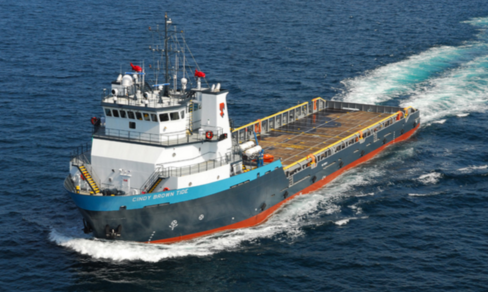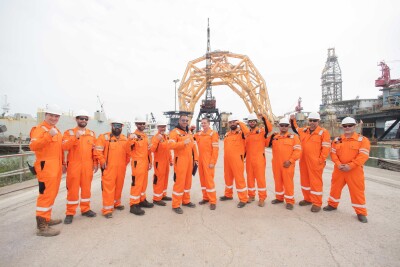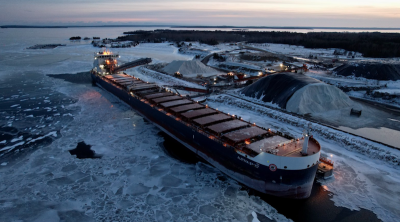Between a persistent pandemic’s assault on fossil fuel demand and an epic storm season, the Gulf of Mexico seems to have been cast into some kind of ecclesiastical time warp this year.
Yet, even as 2020 mercifully wraps up, most agree it will be at least mid-2021 before a clearer picture emerges on the how the offshore sector will shake out after a chaotic year that saw budgets slashed, projects deferred, more bankruptcies, and offshore service vessels (OSV) sidelined at its highest clip in two years. Clouding the crystal ball is the relentless tentacles of the untamed Covid-19 epidemic and the accompanying erosion of demand and commodity prices.
“In March, when the Covid pandemic was really getting started, we saw a very swift coldstacking of vessels, and after that more vessels got cut from long-term jobs,” said IHS Markit Senior Marine Analyst Richard Sanchez.
With the coronavirus hanging in the balance, the big question mark is the direction oil prices will take and how they will fit within offshore operators’ asset portfolios, said veteran energy analyst G. Allen Brooks. “Obviously, there’s going to be a certain amount of activity that’s programmed and the spending locked in, so you have to assume it will go forward. The big thing is for people to feel confident where oil prices are going,” he said.
Confidence certainly hasn’t been on display this year with 14 drilling rigs working in the Gulf of Mexico as of Oct. 2, according to Baker Hughes. Over the first nine months of 2020, the Bureau of Safety and Environmental Enforcement (BSEE) received and approved only 27 drilling permit requests for new wells in waters deeper than 3,000’, 15 of which were issued to Shell Offshore for wells in water depths up to 9,636’. BSEE issued 46 permits for similar water depths over the same Jan. 1 to Sept. 8 time frame last year.
At least one player in an otherwise largely tightlipped OSV community believes the rig count has bottomed out and can only go up from here. “I think that is the bottom, but I also think it will be mid-next year before we get any clarity as to what’s going to happen,” said Matthew Rigdon, executive vice president and chief operating officer of Jackson Offshore Operators LLC, Houston. “I’m optimistic we’ll see activity starting to accelerate toward the latter half of next year. I think it’s not unreasonable to think that we could get back to 20 or so rigs in the Gulf by the end of next year. That may be a little aggressive and too optimistic, but it’s not unreasonable.”
Brooks said the one certain thing is that nearly all rigs put to work will be drilling identified prospects, rather than what was once called “rank wildcats,” as operators try to boost production from established fields. “We’re not going back to doing a lot of exploration drilling. Development drilling will drive the Gulf of Mexico, because there’s a lot of capital that’s already been put in place.”
Compounding a downturn for which there is no playbook, production platforms and OSVs also spent a good chunk of the summer and early fall waiting on weather amid an atypically active hurricane season that forced recurring evacuations while adhering to strict Covid-induced protocol.
During an especially stormy September, an average of nearly 222,499 bpd of oil and just under 525,500 Mcfd of gas were temporarily shut-in from up to 147 platforms, according to BSEE monitoring data.
If this wasn’t enough to elevate the angst level among offshore companies, 2020 also saw an acceleration of investors’ aversion to fossil fuel companies, reinforced when ExxonMobil was booted off the Dow Jones Industrial Average in late August, ending a 92-year run. With that, Chevron is the only traditional oil and gas operator remaining on the Dow, and many of its contemporaries are starting to refocus much of their business on offshore wind and other emerging renewable energy sources.
THE COST OF COVID
In the latest numbers available, the National Ocean Industries Association (NOIA) documented 382 confirmed Covid-19 cases within the Gulf of Mexico oil and gas infrastructure as of Aug. 31, including high-profile outbreaks on BP and Shell platforms in March and May, respectively. “In the last 14 days, the active COVID-19 count is 14," NOIA spokesman Justin Williams said in a Sept. 2 email. “We have had an increase but considering the offshore worker pool is about 25,000 employees, with about 15,000 of them offshore at any given time, it is clear that the mitigation measures are being adhered to and are making a positive impact.”
By jump starting mitigation efforts in late January, Murphy Oil Corp., which operates 13 deepwater Gulf of Mexico fields, said it had identified only one positive Covid-19 case as of August. The aggressive crisis management initiative included the procurement of around 4,000 test kits and rigorous facility sanitization. “We were ahead of the game,” President and CEO Roger Jenkins said in the company’s second-quarter earnings call on Aug. 6. “We didn’t do just fever tests. We also do these prick tests where you can get your blood and test it very quickly. We screened a lot of people.”
Aggravating the obvious hit to revenue streams, those mitigation measures have contributed to millions of dollars in incremental costs that OSV companies and others have incurred to deal with the Covid pandemic. Vessel companies with international footprints have also had to work around inter-country travel and quarantine restrictions, which have forced crewmembers to overstay hitches for extended periods.
“Companies have experienced delays in crew changes in different parts of the world, depending on the various quarantine requirements,” Sanchez said. “In some cases, it’s meant they’ve had to pay for double crews, because the other crew is quarantined.”
Tidewater Inc. alone earmarked $20 million for “frictional costs” associated with the pandemic. “We see this as the annual impact of the crisis,” President and CEO Quintin Kneen said in the company’s July 31 second-quarter earnings call. “This is the increased cost of travel and salaries, cost of quarantine mariners, the cost of fuel to transit vessels coming off hire to their layup locations, and the incremental cost of those vessels being in a layup.”
By mid-September, Tidewater at least managed to begin returning an undisclosed number of mariners stranded within its four global operating regions to their home countries. “It’s still a challenge, like the whole shipping industry, but the good news is we’re slowly starting to see countries open up their borders again,” Jason Stanley, vice president of marketing and investor relations, said on Sept. 16. “In about every region, I think we’ve been able to affect at least one crew change. It’s very slow, but at least it’s progress.”
Meanwhile, the pandemic likely proved to be the final blow for three debt-laden offshore drilling contractors, which filed for Chapter 11 protection, with at least two others speculated to join them in bankruptcy court. Forty-year-old OSV operator Hornbeck Offshore Services Inc., Covington, La., however, emerged from bankruptcy on Sept. 4 after filing in May.
“It's been a very tough time for offshore drilling and oilfield services in general," Valaris plc senior vice president of business development Alan Quintero said in a Sept. 15 virtual presentation to the International Association of Drilling Contractors (IADC), less than one month after the world’s largest offshore rig contractor filed for bankruptcy.
Valaris’ filing followed Noble Corp. and Diamond Offshore, which sought bankruptcy protection in late July and April, respectively, while Transocean Ltd. was granted court permission on Sept. 3 to proceed with a debt restructuring plan, thereby avoiding bankruptcy for now. The fates of troubled Seadrill and Pacific Drilling remained up in the air in late September. Pacific skipped over $50 million in interest payments due Oct. 1.
If nothing else, Brooks said the cleaned up balance sheets will enable contractors to profitably re-price rigs more in alignment with today’s operating climate. “You get rid of all that debt and you don’t need $700,000 (a day) to make a decent cash positive return,"” he said.
HISTORIC PRESSURES
Day rate negotiations are likely secondary concerns for many vessel owners, which have too many boats chasing too few jobs. “Boats are under historically severe pressures, maybe more than ever,” said Sanchez. “When (drilling) rigs roll off contract, we’re seeing anywhere from three to six boats being turned loose, so the spot market is really slowing down.”
Even demand for the top end 4,000- to 5,000-dwt platform supply vessels (PSV) has fallen significantly in the wake of Covid, while the smaller shallow-water boats (1,500-3,000 dwt) have hit rock bottom with the wholesale collapse of jackup drilling, he said. “In the immediate term this year, we’re really seeing a downturn in the demand for the big boats and a lot of them are getting tied up at the docks,” Sanchez said.
In its most recent quarterly status report, Tidewater listed 121 of its diversified 192-vessel fleet as working globally at the end of second quarter, down 26 active boats year-over-year. Kneen sees activity hitting bottom in the first quarter of 2021 and hopefully begin to recover “slowly” as the year progresses. “I think we’re not going to be back to where we were before this crisis began by the end of ‘21, but I think we’ll be close. That’s my expectation based on activity levels and projections today,” he said in the July earnings call.
In the meantime, Tidewater is continuing a sweeping disposal program with 25 vessels sold in the first half of 2020, bringing it closer to the cumulative 46 vessels planned for sale by year-end. “We’ve been pretty aggressive and trying to lead the market. The best thing we all can do is get rid of some old boats that aren't viable anymore and get them out of the equation,” Stanley said.
On a more concentrated scale, Rigdon said all five of Jackson Offshore’s 4,357-dwt to 5,069-dwt PSVs are under term contract through 2021 with only one scheduled to roll off contract by the end of the next year. While the quintet is stationed in the Gulf of Mexico, he sees opportunities emerging in Trinidad and neighboring deepwater hot spot Guyana, which is serviced nearly entirely by U.S.-flagged vessels, given their comparably higher liquid mud carrying capacity.
“Those are the two markets outside the Gulf that we remain focused on,” he said. “We just haven’t had the opportunity yet, but some of our clients are active in Trinidad and Guyana, so it’s likely we get to working there before too long.”
Emerging opportunities are also being found in the nascent U.S. East Coast offshore wind energy sector, where Stanley said three Tidewater vessels have been involved, on and off, in site surveying. “That's (offshore wind) picking up for sure. It’s been talked about for some time, but now seems to be getting some momentum,” he said. “It’s pretty exciting to see some of that take place.”



.png.small.400x400.png)

